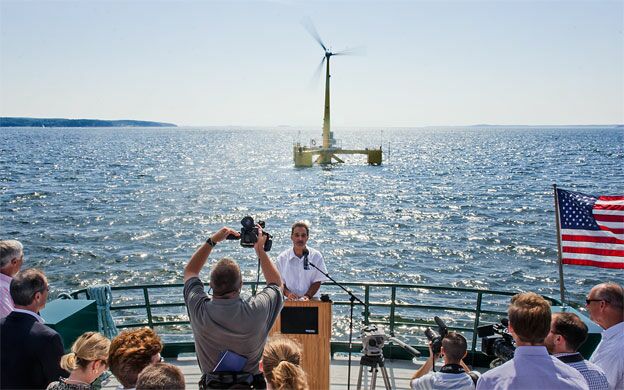Bill to protect Monhegan's iconic scenery would effectively 'kill' offshore wind pilot project
 File photo / James McCarthy
Habib Dagher, director of UMaine's Advanced Structures and Composites Center, in front of the VolturnUS prototype wind turbine deployed off the shores of Castine in 2014.
File photo / James McCarthy
Habib Dagher, director of UMaine's Advanced Structures and Composites Center, in front of the VolturnUS prototype wind turbine deployed off the shores of Castine in 2014.
Legislation proposed by Maine Sen. Dana Dow, R-Waldoboro, to prohibit The New England Aqua Ventus 1 project from building two 6-megawatt wind turbines two-and-a-half miles off Monhegan Island could kill the University of Maine-led effort.
For now, it is one of only two projects still in the running for $40 million Department of Energy, contingent on reaching specific milestones and subject to continued congressional appropriations. DOE will be hosting two public sessions on the project — in Tenants Harbor on Tuesday, Feb. 28, and on Monhegan on Wednesday, March 1.
Dow's bill, LR 1613, “An Act To Protect Monhegan Island,” would prohibit the placement of a wind energy test area — with turbines roughly 585 feet tall — within 10 miles of the Monhegan Lobster Conservation Area. In a Feb. 7 press release announcing his proposal, Dow says the measure is critical to safeguard the iconic island's scenery as well as protect the population of migratory birds that use the island as an important landfall along the North Atlantic Flyway.
“Mainers would never allow a massive wind turbine experiment to be placed within a short distance from the top of Mount Katahdin or near the shores of Acadia National Park, because these are special places and so is Monhegan Island,” he said.
But Habib Dagher, project leader for the UMaine-led consortium involved in the Aqua Ventus project, told members of the Legislature's Energy, Utilities and Technology Committee during a 50-minute briefing on Feb. 7, that moving the test site beyond three miles of Monhegan would put it in federal waters. And that's a problem at this stage in the development effort.
“Under the federal permitting process, if we were to move this site into federal waters it would delay the project by close to five years,” he said. “Basically, it would kill the project.”
Dagher told committee members the only other project still in the running for DOE funding is an Ohio project to build six wind turbines with nearly 21 megawatts of generating capacity in Lake Erie. DOE pulled the plug earlier this year on a New Jersey company's plans to install six 4MW turbines in state waters about three miles off Atlantic City, N.J., citing the project's failure to reach a power agreement by the Dec. 31 deadline for another round of funding.
With a power purchase agreement already approved by the Maine Public Utilities Commission in 2014 and the Mohegan test site designated in 2009 by the Maine Department of Conservation being approved, Dagher told committee members the Aqua Ventus project has avoided trip-ups that led to other projects being dropped by DOE.
Jake Ward, vice president for innovation and economic development at UMaine, said the goal is to install the floating hulls at the Monhegan test site by fall 2019.
How Monhegan test site was selected
In his Feb. 7 presentation, Dagher told committee members the Monhegan test site is the farthest offshore test site identified in the state’s 2009 selection process, which gives the Aqua Ventus pilot project the opportunity to test the effectiveness of its full-scale floating semisubmersible concrete hulls as platforms for two 6 megawatt wind turbines.
“It gives us the deep water and the high winds that are out there,” Dagher said. “The fishermen helped locate that site. It’s where there was little or lobstering at the time and no groundfishing at all. So it minimized the impact.”
Dagher reassured the committee that the enabling legislation specifies that the Monhegan site can only be used as a test site. “It can never be a fully commercial site,” he said.
Since the selection, UMaine and its Aqua Ventus corporate partners, which include Cianbro and Emera Maine, have used DOE funding to collect data and conduct environmental studies for the site, including data on birds and marine life, noise and vibration studies, visual studies and cultural/historical studies.
“This is the most studied test site on the coast of Maine,” he said. “All of that costs millions of dollars over the years. All of the studies and reports were done to make sure that we understood the impact of these units on the environment around them.”
Update on project's milestones, potential
Ward told the committee that since last spring, when DOE elevated the Aqua Ventus project from its status as an "alternate" to being one of three finalists to receive up to $40 million over three years, the consortium has been working out details for design and construction, maintenance and grid integration.
The public scoping sessions scheduled this week represent a key milestone in the permitting process, he said.
Dagher said the Monhegan pilot project offers a unique opportunity to prove the effectiveness of the concrete floating hull technology and potentially create demand for Maine-made units not only for commercial offshore wind projects in the Gulf of Maine but for any offshore wind project.
“Instead of a 20-to-25-year lifespan, we’re looking at a 100-year lifespan,” he said, adding that the floating hulls can be built in modules in assembly-line fashion, which would drive the costs down as production scales upward. “When this technology goes to commercial production and we start building larger farms, we should be able to get down to 7.7 cents per kilowatt hour plugged into the grid … That’s definitely a major milestone. It would show that with our technology we can compete with just about any offshore wind technology that exists anywhere else in the world. It’s very exciting.”
Protect Monhegan opposes project
Last fall, Travis Dow, a spokesman for the group Protect Monhegan, told Maine Public that many of Monhegan's residents didn't know that the project would grow from a small, temporary project demonstration into a 12-megawatt offshore wind operation. Dow added that he and several other residents believe that the construction of the project's 600-foot turbines would hurt the community's tourism economy and should be moved.
"We have a solid tourism industry," Dow told Maine Public. "It carries this town. There's no question that we're a huge bird migrating stop. It's probably the most important stop on the North Atlantic flyway for migrating birds. It's not the right site. Maine has 230 miles of coastal waters and 3,000 miles of coastline. There's got to be a better place than right next to Monhegan Island."













Comments